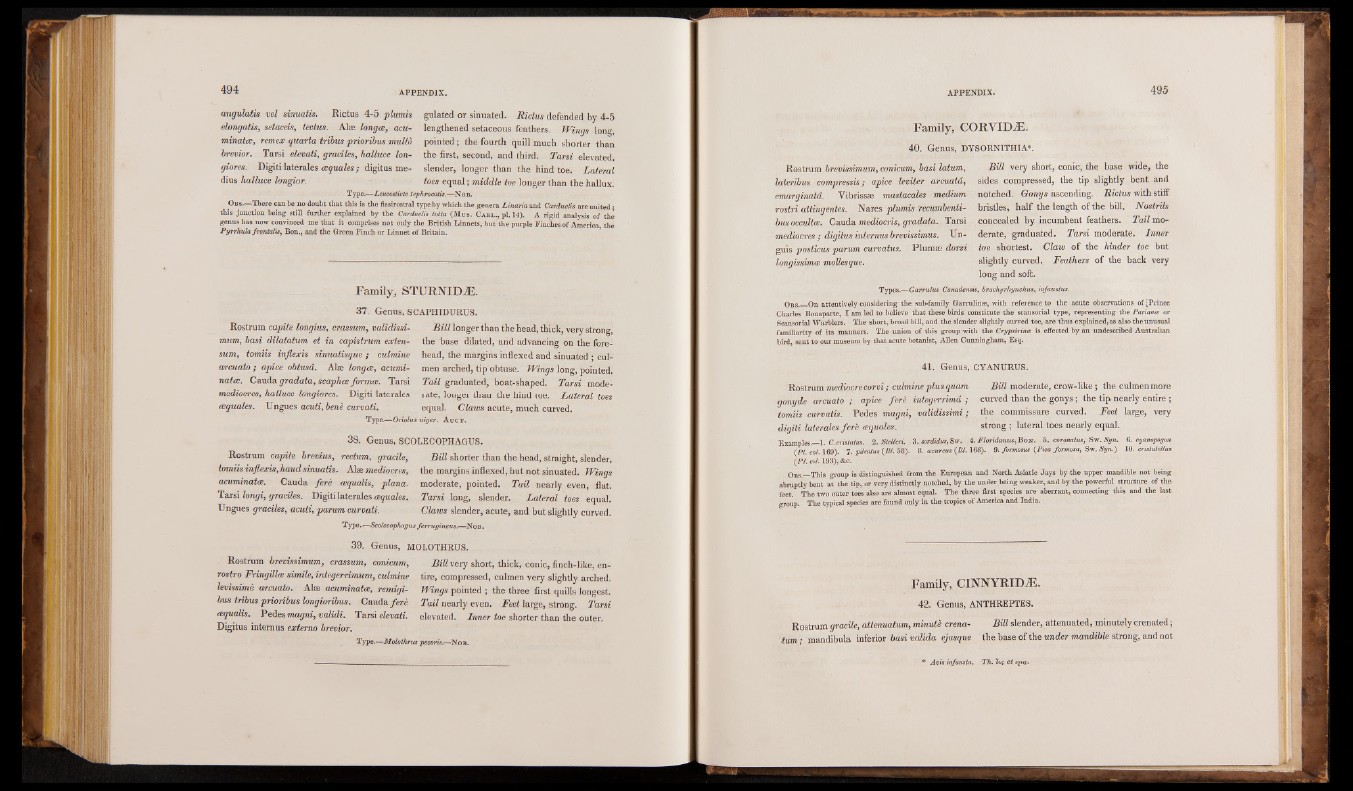
angulatis vel sinuatis. Rictus 4-5 plumis
elongatis, setaceis, tectus. Alæ long ce, acu-
rninatoe, remex quarta tribus prioribus multo
brevior. Tarsi elevati, graciles, halluce Ion-
giores. Digiti latérales oequales ; digitus médius
halluce longior.
Type.—Leucosticte U
gnlated or sinuated. Rictus defended by 4-5
lengthened setaceous feathers. Wings long,
pointed; the fourth quill much shorter than
the first, second, and third. Tarsi elevated,
slender, longer than the hind toe. Lateral
toes equal; middle toe longer than the hallux.
hrocotis.—Nob.
Obs.—There can be no doubt that this is the fissirostral type by which the genera Linaria and Carduelis are united;
this junction being still further explained by the Carduelis totta (Mus. Carl., pi. 14). A rigid analysis of the
genus has now convinced me that it comprises not only the British Linnets, but the purple Finches of America the
Pyrrhula frontalis, Bon., and the Green Finch or Linnet of Britain.
Family, STURNIDÆ.
37. Genus, SCAPHIDURUS.
capite longvus, crassum, validissi
mum, basi dilatatum et in capistrum exten-
sum, tomiis inflexis sinuatisque; culmine
arcuato; apice obtusa. Alae longce, acuminates.
Cauda gradata, scaphce formes. Tarsi
mediocres, halluce longiores. Digiti laterales
tequates. Ungues acuti, bené curvati.
Type.—Orioh
B ill longer than the head, thick, very strong,
the base dilated, and advancing on the forehead,
the margins indexed and sinuated ; oilmen
arched, tip obtuse. Wings long, pointed.
Tail graduated, boat-shaped. Tarsi moderate,
longer than the hind toe. Lateral toes
equal. Claws acute, much curved.
niger. AtrcT.
38. Genus, SCOLECOPHAGUS.
Rostrum capite bremus, rectum, gracile,
tomiis inflexis,haud sinuatis. Alæ médiocres,
acuminata. Cauda ferè cequalis, plana.
Tarsi longi, graciles. Digiti laterales OEquales.
Ungues graciles, acuti, parum curvati.
Bill shorter than the head, straight, slender,
the margins inflexed, but not sinuated. Wings
moderate, pointed. Tail nearly even, flat.
Tarsi long, slender. Lateral toes equal.
Claws slender, acute, and but slightly curved.
Type. —Scolecophagus ferrugineus.—Nob.
39. Genus, MOLOTHRUS.
Rostrum brevissimum, crassum, conicum,
rostro Fringillce simile, integerrimum, culmine
levissime arcuato. Alae acuminates, remigi-
bus tribus prioribus longioribus. Cauda fere
cequalis. Pedes magni, validi. Tarsi elevati.
Digitus internus externo brevior.
Bill very short, thick, conic, finch-like, entire,
compressed, culmen very slightly arched.
Wings pointed ; the three first quills longest.
Tail nearly even. Feet large, strong. Tarsi
elevated. Inner toe shorter than the outer.
Type.—Molothrus pecoris.—Nob.
Family, CORVIDÆ.
40. Genus, DYSORNITHIA*.
Rostrum brevissimum, conicum, basi latum,
lateribus compressis; apice leviter arcuata,
emarginatd. Vibrissae mastacales medium
rostri attingentes. Nares plumis recumbenti-
bus occultce. Cauda mediocris, gradata. Tarsi
mediocres ; digitus internus brevissimus. Unguis
posticus parum curvatus. Plumae dorsi
longissimce mollesque.
Bill very short, conic, the base wide, the
sides compressed, the tip slightly bent and
notched. Gonys ascending. Rictus with stiff
bristles, half the length of the bill. Nostrils
concealed by incumbent feathers. Tail moderate,
graduated. Tarsi moderate. Inner
toe shortest. Claw of the hinder toe but
slightly curved. Feathers of the back very
long and soff.
Types.—Garrulus Canadensis, brachyrhynchus, infaustus.
Obs__On attentively considering the sub-family Garrulinse, with reference to the acute observations of [Prince
Charles Bonaparte, I am led to believe that these birds constitute the scansorial type, representing the Parlance or
Scansorial Warblers. The short, broad bill, and the slender slightly curved toe, are thus explained, as also the unusual
familiarity of its manners. The union of this group with the Crypsirince is effected by an undescribed Australian
bird, sent to our museum by that acute botanist, Allen Cunningham, Esq.
41. Genus, CYANURUS.
Rostrum mediocre corvi; culmine plus quam Bill moderate, crow-like; the culmen more
gonyde arcuato ; apice fere integerrimd ; curved than the gonys ; the tip nearly entire;
tomiis curvatis. Pedes magni, validissimi; the commissure curved. Feet large, very
digiti laterales feri cequales: strong ; lateral toes nearly equal.
Examples._1. C.cristatus. 2. Stelleri. 3. sordidus, Sw. 4. Floridanus, Bon. 5. coronatus, Svf.Syn. 6. cyanopogon
{PI. col. 169). 7. pileatus (IV. 58). 8. azureus (PI. 168). 9. formosus (Pica formosa, Sw. Syn.) 10. cristatellus
(PI. col. 193), &c.
Obs.__This group is distinguished from the European and North Asiatic Jays by the upper mandible not being
abruptly bent at the tip, or very distinctly notched, by the under being weaker, and by the powerful structure of the
feet. The two outer toes also are almost equal. The three first species are aberrant, connecting this and the last
group. The typical species are found only in the tropics of America and India.
Family, CINNYRIDJ3.
42. Genus, ANTHREFTES.
Rostrum gradle, attenuatum, minute erena- Bill slender, attenuated, minutely crenated;
turn; mandibula inferior basivalida ejusque the base of the under mandible strong, and not
Avis infausta. ■ Th. Stts et oçvis.